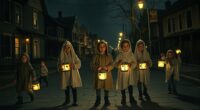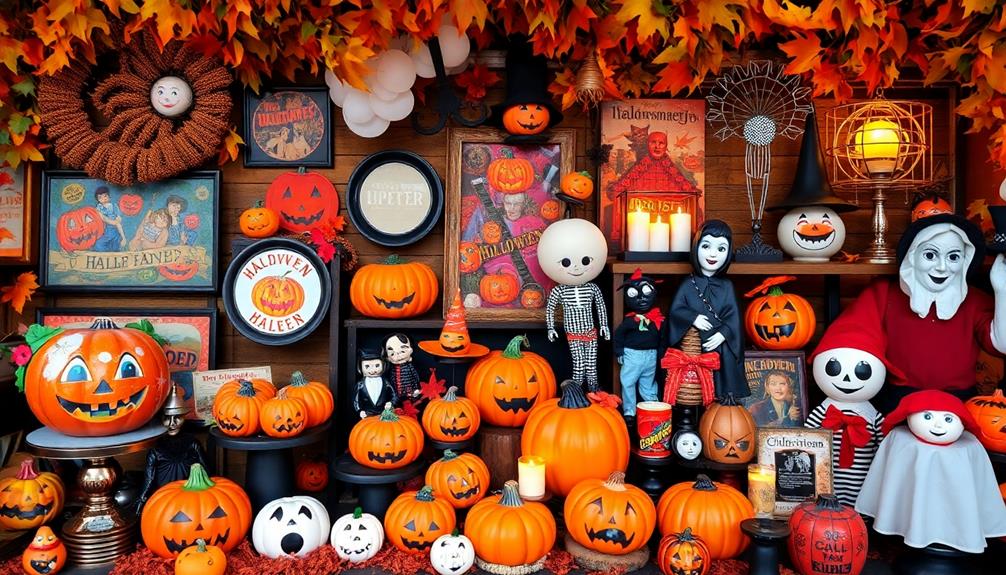Halloween’s roots blend ancient pagan and Christian traditions. It began with the Celtic festival of Samhain, where people believed spirits crossed into our world, leading to rituals like bonfires and costumes to honor ancestors and ward off ghosts. Over centuries, these customs merged with Christian practices, transforming Samhain into All Hallows’ Eve, emphasizing saints and spirits. If you explore further, you’ll discover how these combined influences shape the Halloween you celebrate today.
Key Takeaways
- Halloween originates from the Celtic festival Samhain, marking the end of harvest and honoring spirits crossing into the living world.
- Christian influence transformed Samhain into All Hallows’ Eve, with religious observances honoring saints and martyrs.
- Customs like disguising oneself and lighting candles blend pagan traditions with Christian practices to honor ancestors and ward off spirits.
- Trick-or-treating evolved from medieval souling, combining pagan and Christian rituals of offering prayers and food for the dead.
- Modern Halloween reflects a fusion of ancient pagan and Christian customs, emphasizing costumes, supernatural themes, and community celebrations.

Have you ever wondered where Halloween traditions come from? The roots of Halloween are a blend of ancient pagan rituals and Christian practices that have evolved over centuries. To understand the holiday’s origins, you need to look back to the ancient Celtic festival called Samhain. Celebrated on October 31st, Samhain marked the end of the harvest season and the beginning of winter. It was believed that on this night, the boundary between the living and the dead blurred, allowing spirits to cross into the world of the living. People lit bonfires, wore costumes, and offered food and drink to appease these wandering spirits. These Samhain traditions aimed to honor ancestors and ward off malevolent ghosts, shaping what we now think of as All Hallows’ Eve customs. Over time, Christian influence intertwined with these pagan practices, transforming the festival into All Hallows’ Eve, or All Saints’ Eve. The church designated November 1st as a day to honor saints and martyrs, and the night before became a time for vigil, blending old customs with new religious observances. As Christianity spread across Europe, some of the pagan rituals persisted, but they took on a more religious tone. For example, the practice of dressing in costumes was adapted from the Celtic tradition of disguising oneself from spirits, but now it often symbolized saints or angels. Similarly, the tradition of lighting candles in honor of the dead echoes the ancient practice of lighting bonfires during Samhain. The customs of going door-to-door, which later evolved into trick-or-treating, can be traced back to the medieval practice of souling, where the poor would visit homes asking for food in exchange for prayers for the dead. These All Hallows’ Eve customs gradually merged with local folk traditions, creating a unique blend of pagan and Christian elements. As these traditions traveled across different regions, they evolved further, incorporating local folklore and beliefs. The holiday became more community-focused, emphasizing remembrance, spiritual protection, and celebration of the harvest. Additionally, the preservation of these customs demonstrates the enduring influence of cultural traditions across centuries. Today, many of these ancient practices are still visible in Halloween’s modern festivities, even if their original meanings have faded or been transformed. Understanding the roots of Halloween reveals how a holiday rooted in honoring ancestors and spirits has grown into a celebration that mixes supernatural themes, costumes, and communal activities. It’s a testament to how ancient pagan beliefs and Christian traditions have woven together over centuries to shape the spooky, festive holiday we enjoy today.
Frequently Asked Questions
How Did Halloween Evolve Into a Modern Holiday?
Halloween evolved into a modern holiday through centuries of blending traditions. You carve pumpkins to create jack-o’-lanterns, and costume customs became popular for disguise and fun. Over time, communities embraced trick-or-treating and festive parties, transforming it into a celebration of spooky fun. Today, it’s a lively holiday where you enjoy creative costumes and decorated pumpkins, all rooted in centuries of evolving customs that make Halloween uniquely exciting.
Are There Any Other Cultural Influences on Halloween?
Think of Halloween as a tapestry woven from many cultural threads. Beyond its roots in ancient harvest celebrations and Celtic traditions, other influences shape it today. American pop culture, movies, and costume parties add modern twists, while global customs, like Mexican Día de los Muertos, inspire new traditions. These diverse elements create a festive mosaic that keeps Halloween evolving and vibrant, connecting past and present in a spirited dance.
What Are Common Halloween Symbols and Their Origins?
You’ll see common Halloween symbols like pumpkins and black cats. Pumpkin carving, known as Jack-o’-lanterns, originated from Irish folklore to scare away spirits. Black cats symbolize mystery and superstition, often linked to witches. These symbols have evolved over time, blending fun and superstition. They remind you of Halloween’s rich history, where light-hearted festivities meet ancient beliefs about spirits and protection.
How Do Halloween Traditions Vary Worldwide?
You’ll notice Halloween traditions vary worldwide due to cultural differences. In some countries, people focus on traditional costumes representing local folklore, while others emphasize spooky themes and trick-or-treating. For example, in Mexico, Día de los Muertos is celebrated with altars and costumes honoring loved ones, contrasting with the more ghostly themes in the US. These differences reflect local history, beliefs, and customs, making Halloween a diverse and fascinating celebration globally.
What Are the Health and Safety Tips for Halloween Celebrations?
For a safe Halloween, focus on costume safety by choosing bright, reflective clothing and avoiding masks that block your vision. When handling pumpkins, use sharp tools carefully and supervise children. Always check candy for tampering before eating. Stay visible with glow sticks or reflective accessories and be cautious crossing streets. These tips help guarantee you enjoy the festivities without accidents or injuries.
Conclusion
As you celebrate Halloween, remember it’s more than just costumes and candy—it’s a tapestry woven from pagan and Christian traditions. Embrace the history behind the festivities, and you’ll see that “knowledge is power.” Understanding these roots helps you appreciate the holiday’s true significance, connecting past and present. So, enjoy the night, but keep in mind that history often offers lessons that last beyond just a single evening.









